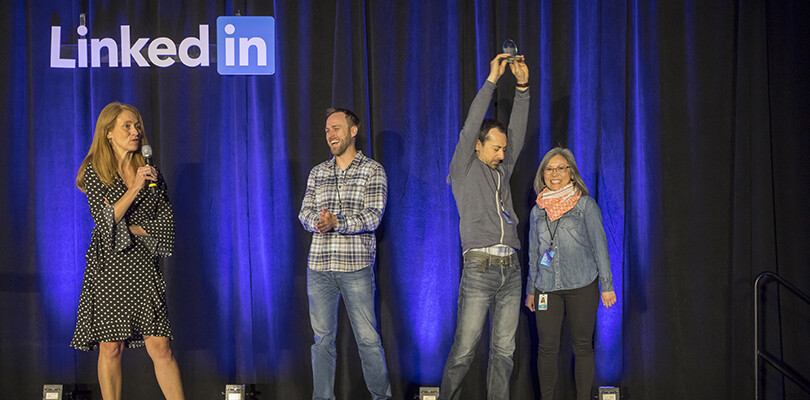Trends, tips, and best practices
7 Reasons Why Your Marketing Department Should Have Regular Off-Site Meetings
As I finish up this blog post, I’m on a 757 flying back to Chicago after a multi-day, off-site meeting. This all-hands meeting brought together LinkedIn’s entire marketing department — more than 500 people —at a San Francisco hotel.
Because of the sheer size of the meeting and the fact that LinkedIn is a global company — marketers flew in from Australia, Brazil, China, England, France, India, Ireland, Singapore, and other points around the globe — the off-site unavoidably demands significant time and budget.
So why does LinkedIn CMO Shannon Brayton regularly hold off-site meetings like this for the entire marketing department? And why should your marketing department consider having similar off-site meetings at a scale that makes sense for your business?
The answer: Because the outsized benefits far outweigh the costs. Here are seven reasons why your marketing department should consider an off-site all-hands meeting:
1. Aligning on Strategy and Priorities
Off-site meetings can have many facets, and a key one is pointing the entire marketing organization toward a shared true north. CMOs can use the occasion to reinforce standing priorities and to introduce new ones, such as new brand guidelines. Bringing the entire team together out of the office underscores the importance of the message, limits distractions and reinforces that we’re all in it together as a team.
2. Building and Reinforcing Company Culture
Among LinkedIn’s clear and oft-stated goals is having their employees learn new skills, take intelligent risks, and become not only better employees but improved people, too. At our off-site, marketers had the opportunity to take small classes on coding, building an international team, storytelling, and even mixed martial arts skills. The small size of these breakout sessions also ensured that we’d be learning with colleagues we’d probably never met before. I know my own number of LinkedIn connections saw significant growth this week.
3. Celebrating Individual and Group Achievements
During the off-site, LinkedIn recognized standout work among its marketers with the LinkedIn Impact Awards In a handful of categories, such as Storytelling and Act Like an Owner, marketing team members were celebrated for effective and inventive work in front of their peers. The winners loved the recognition, especially for being singled out among such strong competition and talented colleagues. Others are now motivated to take steps to ensure the projects they currently have in motion find them on stage receiving an Impact Award at next year’s marketing all-hands.
4. Connecting Far-Flung and Remote Employees
Because of LinkedIn’s size and scope, individual marketing employees work with colleagues around the globe and in a range of time zones. Of course, we stay in touch with email, BlueJeans meetings, and Microsoft Teams, but nothing can fully replace shaking hands and meeting face-to-face. An off-site gives the opportunity for colleagues to have the kind of productive interactions had in chance meetings or over meals, where new ideas can be nurtured and old ideas can be resurrected. At this off-site, I personally talked with colleagues from Australia, China, India, and Singapore about starting new content projects or rekindling old ones.
5. Learning from Experts Outside the Company
No single company has cornered the market on innovation, wisdom, and knowledge. At our most recent off-site, we were lucky to hear a number of speakers outside LinkedIn, such as former GE CMO Beth Comstock and former Teen Vogue Editor-in-Chief Elaine Welteroth. Comstock, who has written a soon-to-be-published book, “Imagine It Forward,” shared that she often asked her team members this open-ended question, “What can you tell me that I don’t want to hear?” Welteroth described how she began reshaping Teen Vogue’s content to move far beyond beauty and fashion when she realized that the content they had been producing was boring her and her staff. You can’t bore people into reading your content, you have to interest them.
6. Sharing Swag
Off-sites are often an occasion for sharing company swag. I regularly wear my various LinkedIn jackets, hoodies, and hats secured at off-sites and other meetings. It’s an opportunity to give your employees a gift that they can wear to show of the pride they have in the company they work for.
7. Having Fun as a Group
After the meeting, there’s nothing like a party to bring people together. At our most recent off-site a live karaoke band and a deejay traded time on stage, but it was my fellow LinkedIn colleagues who stole the show on the dance floor and on the mic. A shout out to Keith Browning and his jaw-dropping version of Elton John’s “Crocodile Rock.”
The communal power of these off-sites cannot be overstated. They have lasting impact. As I’m flying home — tired but energized at the same time — I’d like to emphasize that the size of your company or your department doesn’t matter when contemplating an off-site meeting. At my former company, Bizo, which was acquired by LinkedIn in 2014, CEO Russ Glass insisted on two all-hands meetings a year, even when the start-up had just a handful of employees.
The amazing camaraderie built at these events, which were known as Bizopalooza, always surfaces, even to this day, whenever I see someone I worked with at Bizo. The impact of these LinkedIn marketing off-sites is just as powerful. I suspect it will be at your company, too.
To keep pace with the latest in marketing, subscribe today to the LinkedIn Marketing Blog.
Topics: Trends, tips, and best practices
Related articles




